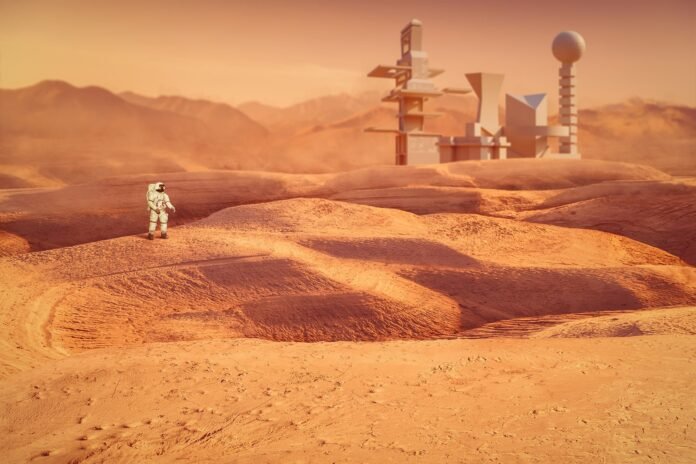
Scientists developed living materials that turn Martian dust into structures using synthetic lichens. This innovation enables autonomous Mars construction.
Living on Mars has long captured the imagination, often portrayed as a distant goal rooted in science fiction. Yet, with multiple successful missions to the planet over the past 50 years, turning this vision into reality now seems increasingly within reach.
However, colonizing Mars involves more than just making the trip. One of the most significant challenges lies in constructing buildings so far from Earth. Launching spacecraft filled with heavy construction materials is neither cost-effective nor sustainable. This raises a key question: how can we build using only what Mars has to offer?
Dr. Congrui Grace Jin from Texas A&M University may have found a promising solution.
Working with collaborators at the University of Nebraska-Lincoln, Jin has spent years researching how to create engineered living materials through bio-manufacturing. Together, they have developed a synthetic lichen system capable of producing building materials independently, without human input.
Their latest research, supported by the NASA Innovative Advanced Concepts program and featured in the Journal of Manufacturing Science and Engineering, explores how this system could be used to build structures on Mars using local regolith—a mixture of the planet’s dust, sand, and rock.
Revolutionizing extraterrestrial building
This breakthrough offers a transformative approach to off-Earth construction, allowing for the creation of structures in extreme environments using limited local materials.
“We can build a synthetic community by mimicking natural lichens,” says Jin. “We’ve developed a way to build synthetic lichens to create biomaterials that glue Martian regolith particles into structures. Then, through 3D printing, a wide range of structures can be fabricated, such as buildings, houses, and furniture.”
Other researchers have explored different strategies to bind Martian regolith, including methods based on magnesium, sulfur, and geopolymer compounds. However, each of these techniques relies heavily on human labor, which makes them impractical given the limited personnel that would be available on Mars.

An alternative has been the use of self-growing microbial systems. Innovations in this area include bacterial biomineralization for turning sand into solid masonry, the use of ureolytic bacteria to produce calcium carbonate for brick formation, and NASA’s investigation into fungal mycelium as a natural binder.
Although microbe-mediated self-growing technology is very promising, the current practices are not completely autonomous because the microbes being used are limited to a single species or strain, thus their survivability requires a continuous supply of nutrients, meaning outside intervention is needed. Again, the lack of manpower on Mars makes this challenging.
Multi-species synthetic community
To solve this problem, Jin’s team has developed a completely autonomous self-growing technology by designing a synthetic community making use of the advantages of multiple species. This system eliminates the need for external nutrient supplies.
The design uses heterotrophic filamentous fungi as bonding material producers because they can promote large amounts of biominerals and survive harsh conditions much better than heterotrophic bacteria. These fungi are paired with photoautotrophic diazotrophic cyanobacteria to create the synthetic lichen system.

How does it work? The diazotrophic cyanobacteria fix carbon dioxide and dinitrogen from the atmosphere and convert them into oxygen and organic nutrients to help the survival and growth of filamentous fungi and increase the concentration of carbonate ions by photosynthetic activities. The filamentous fungi bind metal ions onto fungal cell walls and serve as nucleation sites for biomineral production, as well as enhance the growth of cyanobacteria by providing them water, minerals, and carbon dioxide. Both components secrete biopolymers that enhance the adhesion and cohesion among Martian regolith and precipitated particles to create a consolidated body.
The system grows with only Martian regolith simulant, air, light, and an inorganic liquid medium. In other words, no manpower needed.
“The potential of this self-growing technology in enabling long-term extraterrestrial exploration and colonization is significant,” states Jin.
The next step of the project, already underway, is the creation of regolith ink to print bio-structures using the 3D printing technique of direct ink writing.
Reference: “Bio-Manufacturing of Engineered Living Materials for Martian Construction: Design of the Synthetic Community ” by Nisha Rokaya, Erin C. Carr, Richard A. Wilson and Congrui Jin, 23 June 2025, Journal of Manufacturing Science and Engineering.
DOI: 10.1115/1.4068792
Funding for this research is administered by the Texas A&M Engineering Experiment Station (TEES), the official research agency for Texas A&M Engineering.
Never miss a breakthrough: Join the SciTechDaily newsletter.






